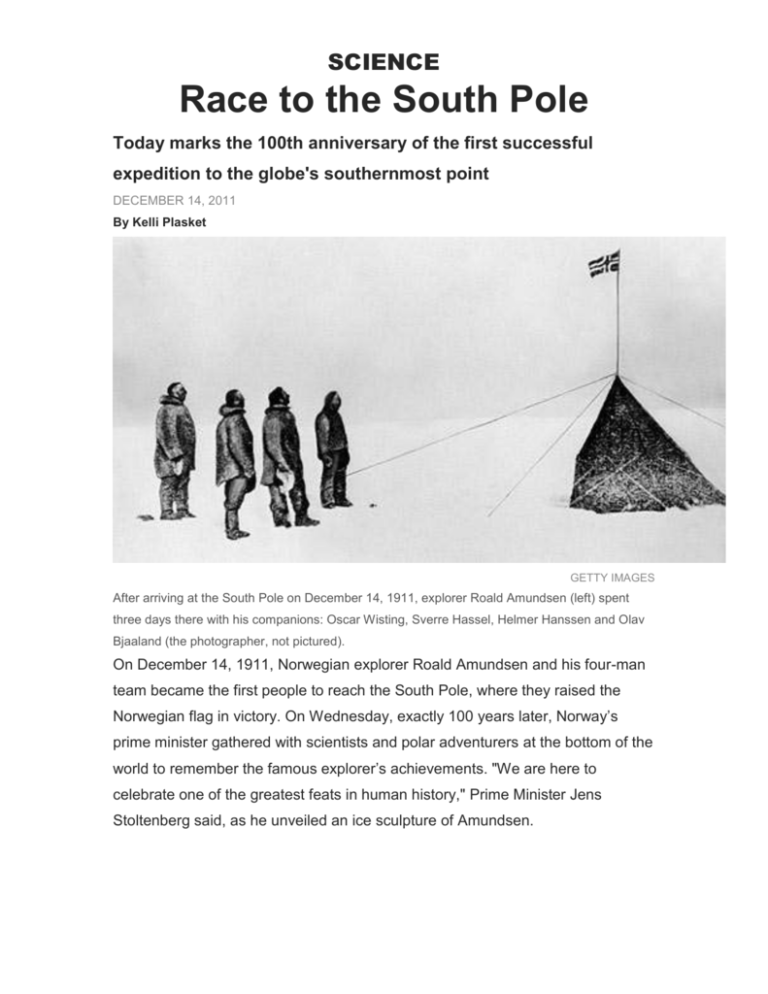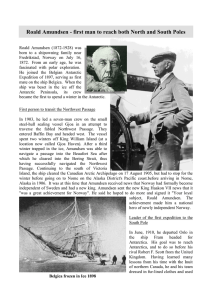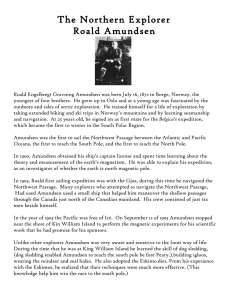Race to the South Pole (Time for Kids)
advertisement

SCIENCE Race to the South Pole Today marks the 100th anniversary of the first successful expedition to the globe's southernmost point DECEMBER 14, 2011 By Kelli Plasket GETTY IMAGES After arriving at the South Pole on December 14, 1911, explorer Roald Amundsen (left) spent three days there with his companions: Oscar Wisting, Sverre Hassel, Helmer Hanssen and Olav Bjaaland (the photographer, not pictured). On December 14, 1911, Norwegian explorer Roald Amundsen and his four-man team became the first people to reach the South Pole, where they raised the Norwegian flag in victory. On Wednesday, exactly 100 years later, Norway’s prime minister gathered with scientists and polar adventurers at the bottom of the world to remember the famous explorer’s achievements. "We are here to celebrate one of the greatest feats in human history," Prime Minister Jens Stoltenberg said, as he unveiled an ice sculpture of Amundsen. SCIENCE Race to the South Pole A Great Expedition TIME & LIFE PICTURES/GETTY IMAGES Norwegian explorer Roald Amundsen became the first man to reach the South Pole on December 14, 1911. In the early 1900s, there was a race to see who could get to the South Pole first. Amundsen beat his rival, British explorer Robert Flacon Scott, by five weeks. On March 8, 1912, after learning of Amundsen's successful expedition, The New York Times wrote: "The whole world has now been discovered." Amundsen was one of the world’s most notable polar explorers. In 1903, he became the first to make a ship voyage through the Northwest Passage, the sea route through the Arctic Ocean on the northern coast of North America. After learning that American explorer Robert E. Peary had reached the North Pole first in April 1909, Amundsen made secret plans for a South Pole expedition. At the time, the South Pole was considered to be the last great, undiscovered territory. On October 19, 1911, Amundsen set out from his base, in Bay of Whales, Antarctica, with four companions, 52 dogs and four sleds. His success in SCIENCE Race to the South Pole reaching the South Pole was aided by careful planning. He took a preliminary trip to drop food and supplies along the first part of his route. His use of sled dogs to carry supplies also helped. Amundsen and his men, along with 11 surviving dogs, made it back to base on January 25, 1912, quicker than expected. In addition to Norway's flag, Amundsen left behind a tent with spare equipment for Scott, and a letter addressed to the King of Norway about his accomplishment. Though Scott eventually reached the South Pole, he died while returning home. On Wednesday, Norway’s prime minister took time to remember the British explorer’s accomplishments, too. "Scott and his men will forever be remembered for their valor and their determination to reach the most inhospitable place on Earth," Stoltenberg said. The two explorers share the name of the research station now located at the South Pole: the Amundsen-Scott Station. A Land of Research Today, Antarctica is a base for a variety of global scientific research projects, from oceanography to cosmology. Cosmology is the study of the origin and structure of the universe. The land holds many clues to Earth's past and future changes, especially those related to global climate change. Wednesday’s ceremony at the pole also served a reminder of the importance of continuing scientific research in this distant place. "The loss of ice in the Antarctic can have grave global consequences,” Stoltenberg said. “Roald Amundsen and Robert Scott and their men went to extraordinary lengths to accomplish their goals. We must be prepared to do the same.”











